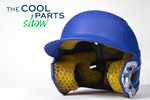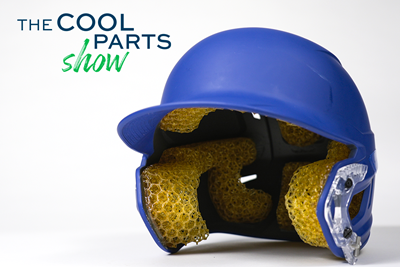Video: Orbit X Pro Football Helmet Uses 3D Printed Lattices
The lightweight helmet from Xenith will be used by NFL and collegiate football players beginning in fall 2024.
More and more sporting goods companies are turning to 3D printed lattices as a potential alternative to conventional foams for protective gear. At NPE: The Plastics Show 2024, materials company BASF displayed a new product that makes use of printed lattice for performance and comfort: the Orbit X Pro, a football helmet from Xenith. But 3D printing doesn’t deliver all the protection alone; instead, the Ultrasint TPU01 lattice is sandwiched between an Ultramid PA 6 injection molded nylon shell for immediate impact resistance and Elastopan/Elastocast polyurethane foam for the player’s comfort. The lattice’s primary role is dissipating the energy from an impact, as well as weight reduction and allowing for airflow through the helmet. The Orbit X Pro is one of the lightest helmets on the market, and will be available to NFL players as well as some collegiate players beginning with the 2024 football season.
Related Resources
- Playlist of sporting goods incorporating 3D printing
- BASF Forward AM’s Ultrasim 3D Lattice Engine for exploring lattice geometries
- A different application for BASF’s Ultrasint TPU
- Another example of 3D printed lattices used for helmet padding
- A rigid 3D printed protective helmet
- More from NPE: The Plastics Show 2024
Transcript
00:00:00:00 - 00:00:15:05
Stephanie Hendrixson
We've been hearing a lot about 3D printed lattices used as padding for protective sporting equipment. Well, at NPE: The Plastics Show, I recently learned about an example of a real product that is coming to the market as of the 2024 football season that is making use of this idea.
00:00:15:07 - 00:00:29:19
I'm Stephanie Hendrixson with Additive Manufacturing Media, and at NPE 2024, in the BASF booth, I learned about the Orbit X Pro from Xenith. This is a lightweight football helmet that makes use of a 3D printed lattice on the interior for impact resistance.
00:00:29:22 - 00:00:37:14
But 3D printing can't do everything itself. There are actually three different BASF materials used in this helmet, and they're all doing different things.
00:00:37:18 - 00:00:57:10
So Ultramid PA12, a nylon material is injection molded to form the hard outer shell. Ultrasint TPU01 is the 3D printed lattice material, and then the innermost layer is a layer of polyurethane foam, which is Elastocast or Elastopan. Each one of these materials is serving a different purpose inside of the helmet.
00:00:57:10 - 00:01:19:15
So that hard nylon shell is optimized for impact performance. They actually use simulation to determine the design and it has regions of greater flexibility and greater stiffness depending on the types of impacts that are expected. The 3D printed TPU lattice actually dissipates energy in the event of a hit, and it also provides for cooling and airflow through the helmet for the player's comfort.
00:01:19:17 - 00:01:40:09
And then that final layer of foam provides a comfortable fit directly against the player's head. This helmet is not going to be custom made. It is going to be available in just a couple of sizes. But the flexibility of that foam and the lattice, combined with Xenith's Adaptive Fit System, means that it's going to be possible for a variety of players with different head shapes and sizes to safely wear this helmet.
00:01:40:11 - 00:01:55:08
The Orbit X Pro weighs just four pounds and one ounce, making it one of the lightest weight helmets available on the market. It's also built from just about ten main components, which means it's easier to manufacture, and it's also going to be easier to maintain for the players and their teams.
00:01:55:08 - 00:02:04:10
This helmet has a five-star rating from the Virginia Tech Helmet Lab, and it's going to be available to NFL and some college players in the 2024 football season.
00:02:04:16 - 00:02:08:14
So the next time you're watching a game, keep an eye out for this helmet on the field.
00:02:08:16 - 00:02:23:17
If you'd like to learn more about how 3D printing is being used in sporting goods, check out our video playlist. We'll link to that in the video description. And if you're interested in more applications with additive manufacturing, follow or subscribe to Additive Manufacturing Media. Thanks for watching.
Related Content
3D Printed Spine Implants Made From PEEK Now in Production
Medical device manufacturer Curiteva is producing two families of spinal implants using a proprietary process for 3D printing porous polyether ether ketone (PEEK).
Read More6 Trends in Additive Manufacturing Technology at IMTS 2024
3D printers are getting bigger, faster and smarter. But don’t overlook the other equipment that the AM workflow requires, nor the value of finding the right supplier.
Read MoreActivArmor Casts and Splints Are Shifting to Point-of-Care 3D Printing
ActivArmor offers individualized, 3D printed casts and splints for various diagnoses. The company is in the process of shifting to point-of-care printing and aims to promote positive healing outcomes and improved hygienics with customized support devices.
Read More3D Printing with Plastic Pellets – What You Need to Know
A few 3D printers today are capable of working directly with resin pellets for feedstock. That brings extreme flexibility in material options, but also requires greater knowledge of how to best process any given resin. Here’s how FGF machine maker JuggerBot 3D addresses both the printing technology and the process know-how.
Read MoreRead Next
3D Printed Lattices Replace Foam for Customized Helmet Padding: The Cool Parts Show #62
“Digital materials” resulting from engineered flexible polymer structures made through additive manufacturing are tunable to the application and can be tailored to the head of the wearer.
Read More3D Printed Bobsled Helmet Improves Safety, Lowers Weight
Additive manufacturing enabled researchers to develop custom-fit bobsled helmets with lattice linings that increased impact resistance and lowered weight.
Read MoreAlquist 3D Looks Toward a Carbon-Sequestering Future with 3D Printed Infrastructure
The Colorado startup aims to reduce the carbon footprint of new buildings, homes and city infrastructure with robotic 3D printing and a specialized geopolymer material.
Read More
.jpg;width=70;height=70;mode=crop)



















